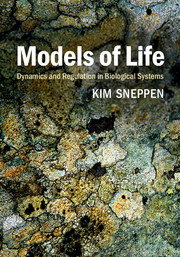Book contents
- Frontmatter
- Contents
- Preface
- 1 Life from a physics perspective
- 2 E. coli as a model system
- 3 Dynamics of regulatory links
- 4 Statistical mechanics of phage λ
- 5 Diffusion and randomness in transcription
- 6 Stochastic genes and persistent decisions
- 7 cis-Acting gene regulation and epigenetics
- 8 Feedback circuits
- 9 Networks
- 10 Signaling and metabolic networks
- 11 Agent-based models of signaling and selection
- 12 Competition and diversity
- 13 Evolution and extinction
- Appendix
- References
- Index
10 - Signaling and metabolic networks
Published online by Cambridge University Press: 05 October 2014
- Frontmatter
- Contents
- Preface
- 1 Life from a physics perspective
- 2 E. coli as a model system
- 3 Dynamics of regulatory links
- 4 Statistical mechanics of phage λ
- 5 Diffusion and randomness in transcription
- 6 Stochastic genes and persistent decisions
- 7 cis-Acting gene regulation and epigenetics
- 8 Feedback circuits
- 9 Networks
- 10 Signaling and metabolic networks
- 11 Agent-based models of signaling and selection
- 12 Competition and diversity
- 13 Evolution and extinction
- Appendix
- References
- Index
Summary
Signaling across networks
Strong components
Cells need to send signals, between each other (see 8.5 and [552]), between compartments inside a cell and between different protein types within a cell. Signals are sent in response to environmental conditions to allow the cell to take appropriate action. Computation by the regulatory system makes sure that the right signals are sent at the right times to specific proteins. Signals are facilitated by reactions of various types, for example enzymatic reactions or transcriptional regulations, as outlined in Fig. 10.1.
As an introduction, we return to E. coli as a model system, including all known regulatory reactions, as analyzed in [527] and shown in Fig. 10.2. To address the large-scale network properties, the first question is to what extent signals can be propagated on or across this network. This depends on the ability to transmit a signal across each link, and also on the logic and sharpness of signal integration at each molecular reaction. Signals that can send multiple links across a network have been seen in the induction of lysis in phage λ (see Fig. 4.6).
Figure 10.2 shows the network of proteins and all the known reactions in E. coli in which these proteins take part. It includes transcription regulation, protein complex formations and enzymatic reactions, but the network does not include the metabolites themselves.
- Type
- Chapter
- Information
- Models of LifeDynamics and Regulation in Biological Systems, pp. 205 - 225Publisher: Cambridge University PressPrint publication year: 2014



